|
This image of a one year old Yellow-crowned Night-Heron was created at Fort DeSoto with the hand held Canon 500mm f/4L EF IS II lens, the Canon 1.4x EF tele-extender III, and the Canon EOS-1D X. ISO 1600. Evaluative metering at zero: 1/250 sec. at f/6.3 in Manual mode. 61-Point/AI Servo Rear Focus AF active at the moment of exposure. Click here if you missed the Rear Focus Tutorial. Click on the image for a larger version. |
Canon 500mm f/4L IS II Hand Held: How Sharp Is Sharp?
You saw some of the hand held images that I created with the 500 II, the 1.4X III, and the amazing 1D X in last Friday’s blog post. The images presented here give you an even better idea of what is possible with the 4-Stop IS system that was first introduced with the Canon EF 800mm f/5.6L IS USM lens and is part of the deal with all of the new Series II Canon super-telephoto lenses. Can you say incredibly sharp?
With the image above I was working at 700mm (14X) at a shutter speed of only 1/250 second. The old rule of thumb for making sharp images hand held was 1 over the focal length of the lens, in this case 1/700 sec. The rule can obviously be thrown our of the window with 4-Stop IS. Do note that with the new lenses it is important to set IS Mode 1 when photographing static subjects hand held (and to switch back to IS Mode 3 for hand held flight and action photography).
|
This vertical front-end portrait of the same bird was also created with the hand held Canon 500mm f/4L EF IS II lens, the Canon 1.4x EF tele-extender III, and the Canon EOS-1D X. ISO 2000. Evaluative metering +1 stop: 1/500 sec. at f/6.3 in Manual mode. 61-Point/AI Servo Rear Focus AF active at the moment of exposure. Click here if you missed the Rear Focus Tutorial. Click on the image for a larger version. |
Coming Soon: The EOS-1D X Autofocus Guide
Sharp-eyed readers will note that for both of the images above I used 61-Point AF. Ah, if it would be that simple…. The 5D III and the 1D X feature a fantastic brand new but complex AF system. I am currently working on the EOS-1D X Autofocus Guide. It will cover all of my AF-related menu item and C.Fn. settings and will include my reasoning for each setting and selection as well as numerous screen capture showing the AF system in action.
1D X High ISO Performance
Note the incredible high ISO performance of the Canon EOS-1D X Digital SLR camera body. The vibrant colors, low noise levels, and crisp detail–see image next–at ISO 1600, 2000, and beyond open up whole new worlds for nature photographers wishing to work in low light. As I have said before and often here, the 1D X has changed my approach to bird photography more than any other camera I have ever held in my hands.
|
This is a 100% crop of the vertical front-end portrait immediately above. It is right out of camera: converted in DPP, unsharpened, no NIK. |
How Sharp is Sharp?
Note the incredible feather detail in this unsharpened ISO 2000 image viewed at 100%. Be sure to click on the image to see the larger version. Do you see the photographer reflected in the bird’s pupil? That’s me hand holding the 500 II. Can you read the serial # of the lens??? (Only kidding.)
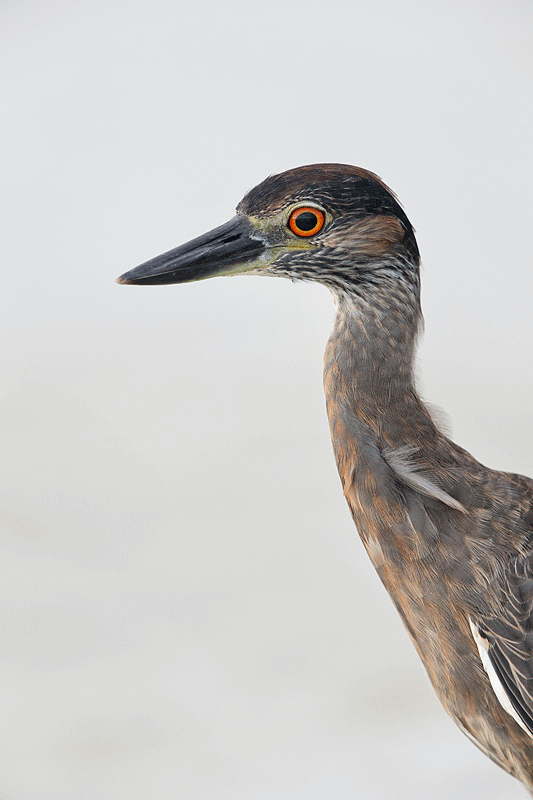
|
NIK Color Efex Pro
As sharp and detailed as the original image is see how much better it looks with a 40% layer of the Tonal Contrast and a 17 layer of Detail Extractor applied. I used a regular layer mask to paint away a large dark blotch or two that was brought up in the background. Then I eliminated the blotches with Content Aware Fill. Note the differences especially in the feathers of the neck, sides of the breast, and what we can see of the wing coverts.
NIK 15% Discount
As regular readers here know, NIK Color Efex Pro has drastically changed my digital workflow. You can save 15% on all NIK products by clicking here and entering BAA in the Promo Code box at check-out. Then hit Apply to see your savings. You can download a trial copy that will work for 15 days and allow you to create full sized images.
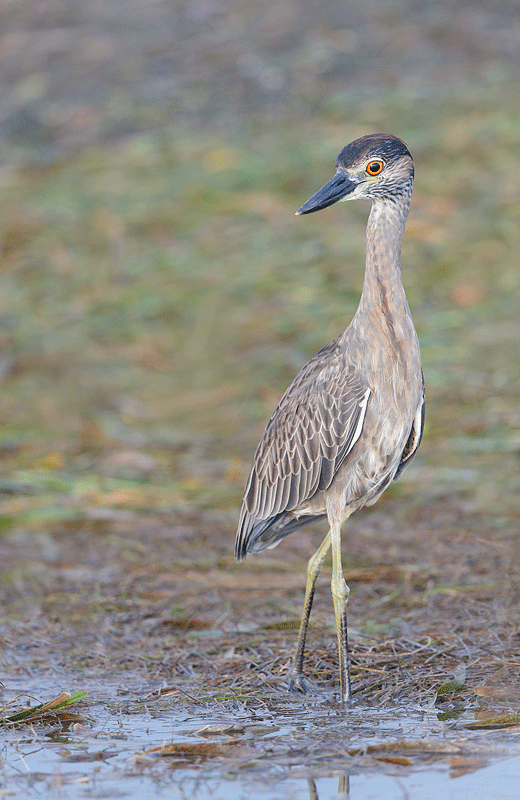
|
Digital Basics Image Clean-Up
Clean-up as usual with a 40% Clone Stamp Tool, a series of Quick Masks with layer masks added, the Spot Healing Brush, and my beloved Patch Tool. All of the above as detailed in Digital Basics, a PDF that is sent via e-mail. DB includes my complete digital workflow, all of my time-saving keyboard shortcuts, and dozens of great Photoshop tips. New that I used above to be added to the next free update of Digital Basics is softening the background using the Structure Slider in NIK’s Viveza. I will do my very best to finish the DB update before I leave for the Southern Oceans on 15 October.
NYC Weekend Nature Photography Seminar
Presented by Denise Ippolito/A Creative Adventure and Arthur Morris/BIRDS AS ART
Hilton Garden Inn, Staten Island, New York. December 8-9, 2012 from 9am-4:30pm.
Weekend: $169. SAT or SUN: $99. Lodging available for out of town guests.
Saturday: Image Capture Sunday: Image Evaluation and Processing
Hilton Garden Inn, Staten Island, New York. December 8-9, 2012 from 9am-4:30pm.
Weekend: $169. SAT or SUN: $99. Lodging available for out of town guests.
Saturday: Image Capture Sunday: Image Evaluation and Processing
Click here for complete details including the Saturday and Sunday schedules, club and group discount info, and registration incentives and for more info on the In-the-Field Seminar Follow-up Workshop.
Artie, the grizzled veteran, is widely noted as one of the premier bird photographers, tour leaders, and educators on the planet. Denise, who specializes in flowers, is the mega-creative up-and-comer, a popular lecturer, a skilled field instructor, and an amazing Photoshop wizard who will share her tips and tricks with you. Both artie and denise are full time professional nature photographers.
BIRDS AS ART Instructional Photo-Tours
Click here for complete IPT information including the current schedule and links to general IPT info, deposit and cancellation policies. and the required registration and release forms.
Shop B&H


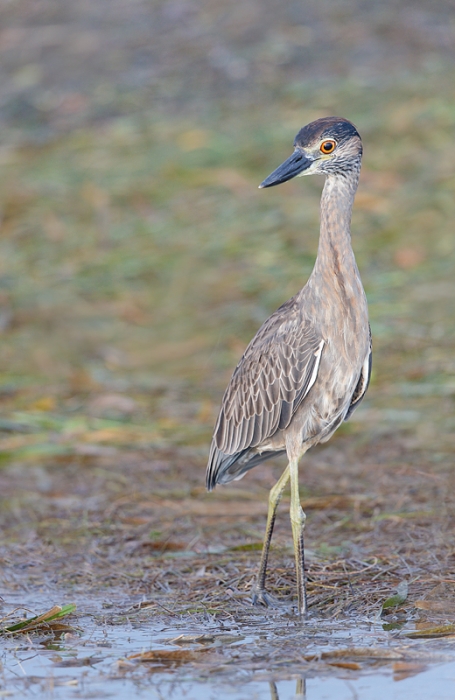
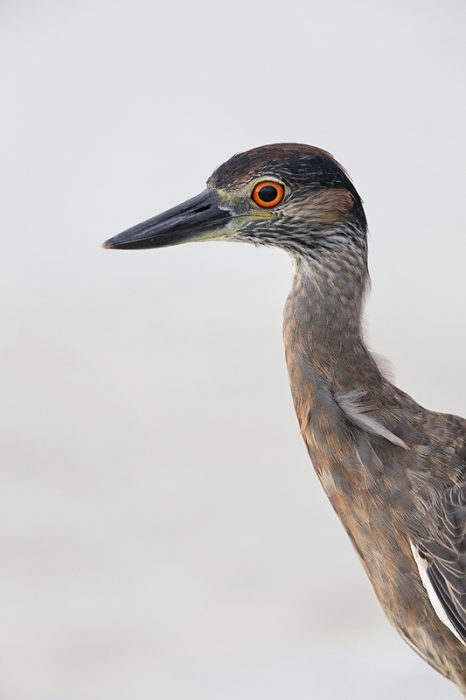
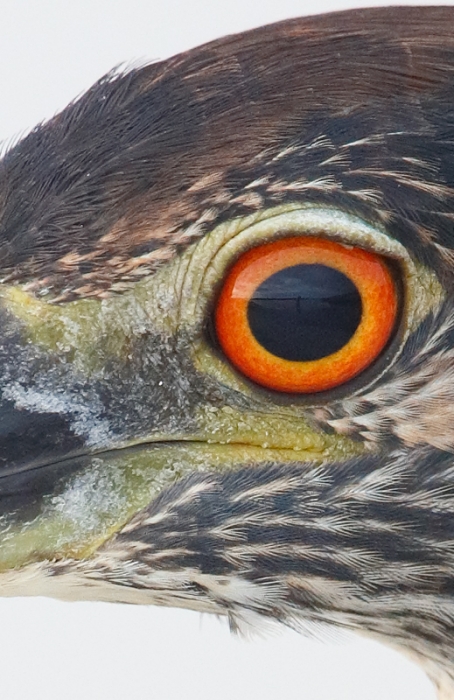
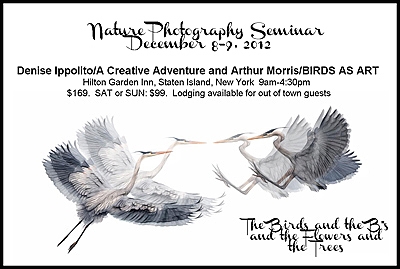













Hello Arthur!
First – a very big THANK for your most interesting articles here that gives me tons of inspiration for to really give bird photography a decent try!
I also are in great need of finding out the optimum solution for bird photography when predominantly using full frame camera – I am sorry to see that for me the 7D never really is giving me the desired IQ I see from my 5MK2 so despite the 1.6 crop factor I still prefer full frame.
So … please can I maybe get an advice to my present dilemma – that I in these days are considering to either purchase the new Canon EF 600 OR when thinking about the weight maybe the better choice of EF500?
First – I rather do like to have a walk-around and hand held bird photograpy.
But – maybe a monopod could be functional option at least to the 600mm?
I have the old EF 300mm f/2.8L IS USM using the latest EF Extender 1.4xIII and 2x III but prefer the EF Extender 1.4x III when hand holding.
I am also very tempted to purchase the new version of the EF300mm f/2.8 II
But – back to the long tele lenses of EF500 II OR the EF600 II with full frame (I am even considering going all the way to the new 1DX or should I only upgrade my 5DMK2 to the MK3 for the better focus functions?
So .. out there at the sea shore – maybe the EF600mm is the better choice…but then again I am not a big muscle superman but more ordinary built man so the use of the EF600mm could be a bit demanding during long walks. But also we use to gradually be stronger and more able by daily training to use more heavy equipement – don´t we?
So please … is the new EF600 II only restricted to be part of a tripod with Gimbal?
or ….hand held…if I could only learning HOW to manage the weight in best way…=?
Wishing you Arthur all the very best and more wonderful shoots with your excellent equipement among the beautiful birds!
Charl (living in Europe/Sweden)
Thanks Charl. Some folks (not me) can hand hold the 600 II. It sounds as if the 500 II would be best for you. You will need to use the 2X III TC with it especially with a full frame body. If you order from B&H please use our link. If you would like to receive their landed cost PDF please e-mail me.
If I had the money I would run to buy this equipment. There is only one life, live it, it’s yours! 🙂
By the way Arthur, that’s an amazingly sharp image, love the orange eye and bright BG.
Hi, Artie, and thanks for all your very helpful comments. You said in response to one of my posts that you’re not sure how spot AF would help in photographing hummingbirds. In my hands, the center AF point on the 7D has a hard time focusing on hte bird itself rather than on a twig or a rock or something else that is covered by the center AF rectangle, which is bigger than it looks. With spot AF, my keeper rate goes way up. Also, I believe cross-type AF points are more accurate at least to f/5.6.
I wish you great travels!
David
Artie,
Those are incredibly sharp images! In your opinion, is it worth it for the extremely expensive price tag of the lens/body combination? I personally feel like Canon is charging an extremely high premium on both the new lens and body. Thanks.
Hi Bryan, As I have said often here and elsewhere, I can never know if something is “worth it” for someone else…. Is the new gear expensive? Surely. But it is difficult to get a 1D X and nearly impossible to get a 500 or 600 II so folks are buying them up as soon as they are available.
Another thing that I have said is that we all get only one ride on the merry go round of life so it is best to enjoy it while you can. If you do decide to buy a ticket, please consider e-mailing and requesting our product-specific B&H affiliate link.
Finally, a question: when you die, do you think that you will have $20K in the bank?
Love the final question… It kind of opens your eyes, doesn’t it…
I always ask myself that when I am thinking of buying something really good 🙂
Images looks incredibly sharp!
Can you make clear: is the IS Mode 3 dedicated for panning in a vertical camera orientation?
I try to set IS 3 for all hand held panning, flight, and action shots regardless of orientation. artie
great work Art! Any estimation of when your 1D X Auto Focus Guide will be released? ~Richard
I worked on it today for 2 1/2 hours on my ISP to MCO flight and then again tonight. One thing that folks do not realize is that when you write this sort of guide that there are dozens of things that must be checked and re-checked and confirmed. I am in the process of doing that now…. Final answer: less than two weeks I hope.
Awesome!! Thanks for putting this together Art!!
~Richard
Hey Artie. What about the 400mmDO for folks who have trouble with the weight of the new 300 and 500? I loved it and it was my go-to hand-held lens for many years. Is it that much less sharp than these new lenses with a teleconverter?
Hey Lou, The 300 f/2.8L IS II is only .91 pounds heavier than the 400 DO. That’s 14 /12 ounces or just under a pound. With the 300 2.8 II you have a far more versatile rig especially when hand holding and yes, it is much sharper than the 400 DO all the way across the board, with and without TCs, hand held or on a tripod. The 4-stop IS is fabulous and I do not hesitate to hand hold it with the 2X III TC.
I have been testing the 300mm f2.8 this week and agree with your assessment (although I also want to check out the 500 if it ever becomes available). I have read your comments about the IS Modes and those in the Canon manual and am still a little unclear about them. It appears to me that 2 and 3 are the same except when IS turns on – Mode 2 half way down and Mode 3 when all the way down. Is that correct and why is it important?
Please specify your recommendations for the IS Modes in these situations:
Using Tripod –
Still subject, subject such as a running animal, birds in flight, and subjects with irregular movements.
Handheld –
Still subject, subject such as a running animal, birds in flight, and subjects with irregular movements.
Impact of low or lower light situations.
As always, your comments are very much appreciated. Thank you.
Mike
Hi Mike,
A search for “IS Mode” in the little white box on the upper right side of the blog brought me here where I wrote:
Image Stabilization Settings: A Whole New World
All four of the new Series II telephoto lenses have three Image Stabilization modes: IS 1, IS 2, and IS 3. Here’s what Canon has to say about each:
IS Mode 1: Corrects vibrations in all directions. It is mainly effective for shooting still subjects.
IS 2 Mode: Corrects vertical camera shake during following shots (i.e., panning) in a horizontal direction, and corrects horizontal camera shake during following (i.e., panning) in a vertical direction. That means that if you hold the camera on end IS2 will realize what you are doing and stabilize in the correct manner.
IS 3 Mode: Corrects vibration only during exposure. During panning shots, corrects vibration in only one direction same as IS mode 2. They continue: Since camera shake is stabilized only during exposure, following a subject is easier such as when shooting a fast and irregularly moving player during sports photography.
With previous generation super-telephoto lenses (including my 800mm f/5.6L IS lens) I have long advised folks to set IS Mode 2 and leave it whether hand holding or working on a tripod and whether photographing stationary or moving subjects. In other words, in the old days it was set it and forget it. Those days are over.
When photographing the Snow Monkeys in Japan with the 300mm f/2.8L IS II lens I quickly learned that the Series II super-telephoto lenses are completely different animals. When I set IS 2 Mode and pressed the shutter button while working on a tripod the image jumped all over the place. I thought that the lens might be defective right out of the box…. I set IS Mode 3 and all was well with the world. Since then I have left the lenses on IS Mode 3 whenever I am on a tripod and been perfectly happy. When hand holding for flight as with the image below, I set IS Mode 3 as well. But when I started making head portraits of the young Great Egret above with the hand held 500mm f/4L IS II lens I very quickly noticed that the image in the viewfinder as a bit jittery. Like me. So I switched to IS Mode 1 when photographing static subjects hand held and the image in the viewfinder calmed right down.
The trick is to remember to toggle back and forth: IS Mode 1 when hand holding for static subjects and IS Mode 3 for hand held flight or tripod-mounted photography. Note also that for for flight photography my very great preference is to the the Limit Range switch to 10 meters to infinity. For close work I need to remember to set it to Full or else the lens will not focus. It will take some getting used to the fact that the Limit Range Switch on all the new lenses has been moved from its traditional position on the side of the lens barrel well in front of the mount to the rear of the lens where I find it a bit inconvenient.
When I get to Bosque I will attempt to discern if there any difference between IS Mode 2 and IS Mode 3 when shooting flight off the tripod.
Using tripod/Still subject: IS Mode 1 is best but the others would likely not hurt you.
Using tripod: animal running at the same speed: IS Mode 2
Using tripod: bird flying erratically: IS Mode 3.
Same for hand held.
In low light/low contrast situations some cameras have more trouble holding focus than others. The 1D X is the best. IAC, it would not affect my choice of IS Modes.
Obviously, none of us, especially me are gonna remember to switch IS Modes as above. What I do right now is leave IS Mode 3 set and try to remember to switch to IS mode only when I am photographing a static subject hand held.
As for your 500mm f/4L IS II, we have had seven of them shipped to folks who kindly ordered using our B&H link to show their thanks for all the free info that we provide on the blog, in Bulletins, and via e-mail. If you would like our product-specific link for the 500 please e-mail me. After you order the lens from B&H you can e-mail me your receipt and I will do my best to expedite your order when they re-open after the Succoth holiday on 10 October. artie
Thank you for a very complete and helpful response. I have got 1 more day for testing before sending it back. I am going to leave it on Mode 3 and evaluate the results. I look forward to seeing your thoughts after Bosque. Definitely need to use your B&H ordering link! Regards, Mike
YAW. If you order before I leave for the South Georgia expedition, I can have it expedited with my B&H contact. artie
Pardon me for jumping in, but the combo 300f2.8 and TCs weighs more than 4Lbs. Mine (mark I) weighs in about 6 lbs and if I recall correctly the. mark II is about 0.5 lbs less. It’s definitely very handhold able and I lug this combo for a couple of miles sometimes. Can’t say that it’s light though, not like the 100-400.
Loi is pretty much correct. As it says on the page that I suggested everyone bookmark here, the 300 II weighs 5.19 pounds. As I have written here, the weight savings with the 300 II is negated by the fact that the tripod collar cannot be removed for hand holding as was possible with the original 300 f/2.8L IS.
Wow. That close-up crop with the reflection in the birds eye is just amazing. *I think I can actually see some nicks and scratches INSIDE the impressions of the letters and numbers of the serial number on your lens…its really just mind blowing.* 😉 I’m still just a novice, but every time I see something like that (noiseless detail and sharpness at ISO’s above 1600) it makes me want to pick up a 1D X the next day! That’s a truly beautiful bird as well. I love its great big, huge eyes and the short beak. Really gives it a bit of that cute, innocent, juvenile look. Wonderful captures.
I greatly appreciate the “Digital Basics” Before & After. I just recently picked up your Digital Basics PDF and have been reading through it, applying the techniques to some of my recent shore bird photos. Its useful seeing which kinds of things you choose to patch over and eliminate. I would really love (and be willing to pay for) a video tutorial demonstrating how you use the patch tool, cloning tool, and healing brush to achieve the final quality when patching big areas. I’ve been unsatisfied with the results of, say, trying to eliminate a whole OOF bird in the background of a shot, or get rid of a branch that passes in front of a perching bird.
Jon, Good idea on the video. Note, however, that all of the info that you want and need is there in DB. You just need to study and practice. Work small. As it states in Digital Basics, use the Patch Tool to smooth any rough edges after making the first patch….
There is a typo in the caption of the first image. It states the exposure was 1/1250 rather than 1/250 as explained later. The 100% crop really tells the story! Amazing what $17757 worth of equipment in good hands can do! 8-]
Thanks Steve. Typo is fixed. Please do not forget that good tools are good tools. If you do not know how to use them, the price tag does not matter. If you got me the world’s most expensive radial arm saw and told me to build a fine cabinet the likely result would be that I would cut off my hand….
Just for the record books, here is the EXIF:
2012:09:16 07:58:06
700mm
1/250 sec, f/6.3
Mode: Manual
Metering: Evaluative
ISO: 1600
AF mode: AI Servo AF
Drive: Continuous (high): frame 1
White balance: Auto
Flash: Off
File size: 23.9MB
Image size: 3456 x 5184
Color space: AdobeRGB
Sharpness level: 3
The crop with your reflection is awesome! Is very impressive IQ at such high iso’s along with great skills. I can certianly see how like you said “1DX has changed my approach to bird photography more then any other camera”.
Was also curious if when you did the NIK Tonal Contrast & Detail Extractor did you do your usual hide-all mask with the effect on the subject only here? I know you stated you used a regular mask for the blotch clean-up.
I also like using the stucture slider in Viveza to soften backgrounds like you did in the first image. Great job of clean-up you did. I’m looking forward to the next DB update, and I’ve also started using DPP a little more for RAW conversions and liking it.
Thanks Artie.
Those Yellow-crowned Night Herons are one awesome looking bird!
Thanks Bobby; you are most welcome! Sometimes I use a Hide-All Mask and sometimes I use the Quick Selection Tool.
When will you be finishing up the guide on the 5DIII?
It is 95% complete. I am not sure when it will be totally done.
Not only is the image sharp for being hand held, I’m blown away by the low noise even at a high ISO. Digital has come a long way since the 90’s.
Lordy, there is no way I can hand hold my 500mm. Wish I could afford the new version. I hate being bound by a tripod but what’s a girl to do? I saw a guy using a Bushhawk the other day, but I don’t think I could even manage that. Probably fall flat on my face..lol
Great shots, Art!
Thanks. There’s always the 300 f/2.8L IS II 🙂 With both teleconverters.
What a fabulous idea! Thank you so much..Now if I can find a good used copy. I’m on a mission..
Not likely to find a used Series II 300 but a very good chance of finding a used 300 f/2.8L IS lens which is killer sharp and just about the same weight.
It has to weigh less than the 500 in any event.. I’ll check the specs.. Thanks so much!
See the page that I refer to in my response to Loi above and bookmark it!
Lynda: In case you don’t remember, Artie published a wonderful summary of Canon telephoto lenses. I can’t post the link here for some reason, but maybe Artie can and will, or maybe you can search the site and find it. Incredibly helpful including for your question. David
It is here and I suggested that everyone bookmark it. I refer to it most every day. 🙂 artie
Linda, the EF 300mm f/2.8 L II with the EF 2x TC III makes a GREAT hand-held combination. I recently used this combination myself (rented) for a couple weeks, 6-8 hours a day. Its about 4 pounds (lens+tc), so nicely hand-holdable if you have a decent shoulder strap or harness to take the load off every once in a while. The IQ is pretty amazing, although lacking that extra wide aperture like the 500mm f/4 II, you don’t get quite the kind of creamy smooth backgrounds you usually see in Art’s photos. If you don’t want to heft around a 500mm lens (although the Mark II’s seem to have dropped quite a bit of the weight), the EF 300mm f/2.8 L II + TC is a nice middle-ground option.
Jon, As I noted above–please bookmark the page I referred to–the300 II weighs 5.19 pounds. Without the 1.4 TC. I agree with everything else that you wrote but for the creamy background comment…. What the 500 has over the 300 is a narrower field of view, but the BOKEH with both lenses is great.
Apologies, I appear to have spelled you name wrong, Lynda!
Oy, my bad. The lens is 5.2 pounds, and a 2x TC adds almost another pound. The full thing is about 6 pounds. I think I looked up the weight of the 100-400mm lens, which is around 3.2 pounds. Apologies for the mixup. That said, I still felt that the 6-pound 300/2.8 II and 2x TC was hand-holdable for around a day. Admittedly, a fair amount of that time I was sitting down or laying down, resting the camera on something (such as my knee) to get stable shots. But it wasn’t a horrible experience by any measure…I didn’t feel particularly fatigued carrying it around all day.
Note to David: it helps if you actually read what I write :): in the How Sharp is Sharp section I wrote, and I quote, “That’s me hand holding the 500 II. Can you read the serial # of the lens??? (Only kidding.)”.
At present I have no plans to test the 6D but a 7D with an improved sensor sounds like a winner to me….
Thanks again, Artie. Sometimes it seems that not everything shows up at once on my screen when I open your blogs, but a thousand lashes to me for not reading carefully enough.
How do you see a 6D as a 7D with a better sensor? It has only one X-type AF point out of only 11, only 4.5 fps, apparently no spot AF (?), only 1/4000 sec max xhutter speed, and so on? I’d seen it as potentially a cheaper, better 5D2, but I’ve never owned any 5D. I do know that I treasure spot AF on my 7D, especially for hummingbirds. David
My understanding is that the 6D has the higher quality sensor of the 5D II. Thanks for pointing out the other differences. I never concern myself with the cross type sensors as my understanding is that they are only beneficial with f/2.8 and faster glass…. And I rarely use Spot AF–not sure how it would be a benefit for any type of hummingbird photography…. artie
Art, how do you define a 100% crop term as used above? A 50% crop etc.? Use of this percentage crop has always alluded me/ Thanks
Artie, I hope you’ll forgive my jumping in here, because I think the term “100% crop” is a dreadful, confusing, counterintuitive term. it’s not 100% of anything. It means that the number of pixels in the image matches the number of pixels on your monitor, at least as I understand it. If that’s wrong–and it could well be–it’s just evidence of how bad the term is.
Again, please fogive me.
David
Bob,
I double-click on the zoom tool to view the image at 100%. Then I set the crop tool to 1024 wide or 800 high. Then I crop the area that I want in my JPEG. It is a bit tricky as you need to keep the crop from going wider than you want it.
David. I never forgive anybody who misspells forgive. 🙂 As above I do not think that it the term needs at all to be confusing; I am showing a crop of the image as viewed at 100%.
forgive forgive forgive
🙂
Thanks, Artie. I was going to ask but Denise answered; that’s your reflection in the bird’s eye, and it is awesome. Reminds me of the first time I got a photo good enough to see my reflection in an animal’s eye: a key deer in Big Pine Key, with an XSi and the kit 55-250 mm lens. Obviously not remotely in the same class as your spectacular image, but nonetheless a revelation.
Will you be testing the Canon 6D? David
Will not be testing the 6D. And let’s not forget what Dan Cadieux has done with the 7D…. artie
That 100% crop with your reflection is awesome!
Thanks Lady D.